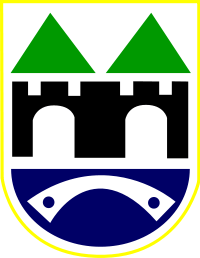Sarajevo during the Middle Ages
| History of Sarajevo |
|---|
|
Ancient times Middle Ages (7th–15th centuries) Early Ottoman era (15th–17th centuries) Late Ottoman era (17th–19th centuries) Sarajevo in Austria-Hungary (1878–1918) Yugoslav era (1918–1992) Modern and post-war (1992–present) |
| See also |
| Timeline of Sarajevo |
The Slavs came to Bosnia in the 7th century, but details of their movement and settlement through the country remain a mystery. Some Slavic artifacts remain from the time however, and it is fairly certain that they settled in the Sarajevo valley, replacing the Illyrians. Katera, one of the two original Bosnian towns that were mentioned by Constantine Porphyrogenitus in De Administrando Imperio, was found to the southeast of Sarajevo. By the time of the Ottoman occupation there was little settlement left in the region, leaving the history of the Sarajevo region during the Middle Ages not well understood.
The first mentions of Bosnia describe a small region, which was basically the Bosna river valley, stretching from modern-day Zenica to Sarajevo. In the 12th century, when Bosnia became a vassal of Hungary, population was mainly members of the Bosnian Church. The area of present-day Sarajevo was part of the Bosnian province of Vrhbosna near the traditional center of the kingdom. Though a settlement called Vrhbosna existed, the exact settlement of Sarajevo at this time is debated. During the High Middle Ages, various documents make note of a place called 'Tornik' in the region. By all indications, 'Tornik' was a very small marketplace surrounded by a proportionally small village, not considered very important by Ragusan merchants. Even the local fortress of Hodidjed was defended by a mere two dozen men when it fell to the Turks.
Others say that Vrhbosna was a major settlement located in the middle of modern-day Sarajevo. Papal documents say that in 1238, a cathedral dedicated to Saint Paul was built in the city. Disciples of the notable saints Cyril and Methodius stopped by the region, founding a church at Vrelobosna. Whether or not the city was located at modern-day Sarajevo, the documents attest to its and the region's importance. Vrhbosna was a Slavic citadel from 1263 until it was occupied by the Ottoman Empire in 1429.[1] Considering the importance of Saint Peter, this would have to have been a very important cathedral, yet nobody is quite sure where it was. Some have speculated that it was located in the present-day Sarajevo neighborhood of Skenderija, as it is said that during construction in the late 19th century, there were found Roman-style columns dating to sometime around the 12th century.
Even disciples of the famous Saint Cyril and Saint Methodius had stopped by the region, establishing a church at Vrelo Bosne. Perhaps a village existed on the outskirts of the city itself, near present-day Ilidža, one of the most attractive regions for settlement in the area, which had been significantly populated for pretty much every other period of its history.
Whether this city was indeed located at modern-day Sarajevo or not, an important city called Vrhbosna did indeed exist at the time and the region was of great importance. Still, it is considered somewhat strange that the location of such an important city is unknown. It is not unlikely that the city may have been destroyed sometime between the 13th century and the Ottoman occupation. It is a well-known fact that foreign armies had often made their way to Vrhbosna in wars with Bosnia, and perhaps one of them razed the city, leaving it in the condition that the Turks found it in the mid 15th century.
References
- ↑ "Sarajevo", Columbia Encyclopedia, edition 6, Retrieved on 3 August 2006 Archived 29 August 2006 at the Wayback Machine.
External links
| Wikimedia Commons has media related to Sarajevo - Middle Ages. |
